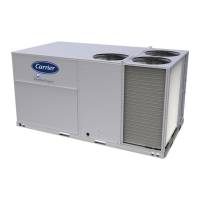27
connection required), use a thermostat cable or equivalent
with minimum of six leads. Check the thermostat
installation instructions for additional features which
might require additional conductors in the cable.
For wire runs up to 50 ft. (15 m), use no. 18 AWG
(American Wire Gage) insulated wire [35_C(95_F)
minimum]. For 50 to 75 ft. (15 to 23 m), use no. 16 AWG
insulated wire [35_C(95_F) minimum]. For over 75 ft.
(23 m), use no. 14 AWG insulated wire [35_C(95_F)
minimum]. All wire sizes larger than no. 18 AWG cannot
be directly connected to the thermostat and will require a
junction box and splice at the thermostat.
X
C
G
W2
C
W2
G
W1
O/B/Y2
Y2
R
W1
R
Y1
Y1
T
H
E
R
M
O
S
T
A
T
(Note 1) (Note 2)
Note 1: Typical multi-function marking. Follow manufacturer’s configuration
Instructions to select Y2.
Note 2: Y2 to Y2 connection required for 2 stage cooling opeation and when
integrated economizer function is desired.
Field Wiring
Central
Terminal
Board
Typical
Thermostat
Connections
C12149
Fig. 41 -- Low--Voltage Connections
Unit without Thru--Base Connection Kit —
Pass the thermostat control wires through the hole
provided in the corner post; then feed the wires through
the raceway built into the corner post to the control box.
Pull the wires over to the terminal strip on the upper--left
corner of the Controls Connection Board. See Fig. 42.
RACEWAY
HOLE IN END PANEL (HIDDEN)
C08027
Fig. 42 -- Field Control Wiring Raceway
NOTE: If thru--the--bottom connections accessory is
used, refer to the accessory installation instructions for
information on routing power and control wiring.
Heat Anticipator Settings —
Set heat anticipator settings at 0.14 amp for the first stage
and 0.14 amp for second--stage heating, when available.
Humidi--MiZer
R
Control Connections
Humidi--MiZer – Space RH Controller —
The Humidi--MiZer dehumidification system requires a
field--supplied and --installed space relative humidity
control device. This device may be a separate humidistat
control (contact closes on rise in space RH above control
setpoint) or a combination thermostat--humidistat control
device such as Carrier’s EDGE
R
Pro Thermidistat with
isolated contact set for dehumidification control. The
humidistat is normally used in applications where a
temperature control is already provided (units with
PremierLinkt control).
To connect the Carrier humidistat (HL38MG029):
1. Route the humidistat 2--conductor cable (field--sup-
plied) through the hole provided in the unit corner
post.
2. Feed wires through the raceway built into the corner
post (see Fig. 42) to the 24--v barrier located on the
left side of the control box. The raceway provides the
UL--required clearance between high--voltage and
low--voltage wiring.
3. Use wire nuts to connect humidistat cable to the leads
in the low–voltage wiring (as shown in Fig. 45), con-
necting PKN to PNK and PNK/BLK to PNK/BLK.
To connect the Thermidistat device (33CS2PPRH--03):
1. Route the Thermidistat multi--conductor thermostat
cable (field--supplied) through the hole provided in
the unit corner post.
2. Feed wires through the raceway built into the corner
post (see Fig. 42) to the 24--v barrier located on the
left side of the control box. The raceway provides the
UL--required clearance between high--voltage and
low--voltage wiring.
3. The Thermidistat has dry contacts at terminals D1
and D2 for dehumidification operation (see Fig. 46).
The dry contacts must be wired between CTB
terminal R and the PNK/BLK lead to the LTLO
switch with field--supplied wire nuts. Refer to the
installation instructions included with the Carrier
Edge Thermidistat device (Form 33CS--74SI or latest)
for more information.
48HC48LC

